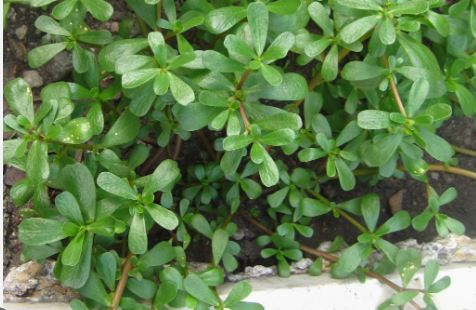
Purslane (Portulaca oleracea) also known as little hogweed, or pursley) is a plant that straddles the line between weed and valuable crop. Originally from India and Persia, it has spread globally and is considered a weed in many places, but it’s also cultivated as a vegetable. it is an annual (actually tropical perennial in USDA growing zones 10–11) succulent in the family Portulacaceae.
Purslane is a succulent annual plant with smooth, reddish, mostly prostrate stems. The leaves are thick, fleshy, paddle-shaped, and arranged either alternately or in small clusters at the stem joints. It produces small, yellow flowers that open singly at the center of the leaf cluster. They have five (sometimes four) petals.
Depending upon rainfall, the flowers appear at any time during the year. The flowers open for only a few hours on sunny mornings. The tiny seeds are formed in a pod that opens when the seeds mature. Purslane has a taproot with fibrous secondary roots and can tolerate poor soil and drought.
The plant grows close to the ground, spreading out in a mat-like formation. it thrives in warm weather and can often be found growing in disturbed soils, garden beds, agricultural areas, sandy, gravelly, and even cracks in pavement. It’s known for its ability to grow in poor, compacted soils. While it’s beneficial, in agricultural settings, it can become a nuisance due to its prolific seed production and the ability to regenerate from stem fragments.
Purslane is one of the highest plant sources of omega-3 fatty acids. It’s also rich in vitamins A, C, and B-complex, as well as minerals like magnesium, calcium, potassium, and iron. Can be eaten raw in salads, added to smoothies, or cooked like spinach. In some cuisines, it’s used in soups, stews, and stir-fries.
This plant has been used for centuries in various cultures for its medicinal properties, treating everything from headaches to gastrointestinal issues. Some studies suggest it might have neuroprotective, antimicrobial, antidiabetic, antioxidant, anti-inflammatory, and anticancer properties, though more research is needed.
Environmental Benefits
- Its extensive root system can help in preventing soil erosion.
- Its presence can indicate soil that has good fertility and is rich in organic matter.
- When cultivated, it can be harvested multiple times in a season due to its rapid regrowth.
Purslane (Portulaca oleracea) Cultivation
- Sow seeds after the last frost when the soil has warmed up, typically in late spring or early summer. Purslane thrives in warm conditions.
- Scatter the seeds on the surface of well-draining soil. Since purslane seeds require light to germinate, they should not be covered deeply. A light dusting of soil over them or simply pressing them into the soil surface will suffice.
- If you’re planting in rows, aim for rows 12-15 inches apart. Seeds can be sown quite densely as you can thin later.
- Seeds germinate within 7-14 days with adequate warmth and moisture.
- Keep the area weed-free, especially in the early stages, to reduce competition.
- You can start harvesting when the plant has enough leaves, typically around 6-8 weeks after sowing. Pick the young leaves and stems for the best flavor and tenderness.
- Snip off the stems or leaves with scissors or pinch them off. Purslane regrows quickly, allowing for multiple harvests in a season.
- Cutting back the plant encourages bushier growth. You can harvest up to one-third of the plant at a time.
- Generally, purslane has few pest issues, but watch out for common garden pests like aphids or slugs. It’s relatively disease-resistant, but can occasionally suffer from fungal issues.
- Plant near crops that could benefit from its ground-covering properties, like taller vegetables, but avoid planting where it might overwhelm or shade out smaller plants.